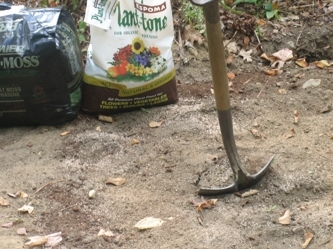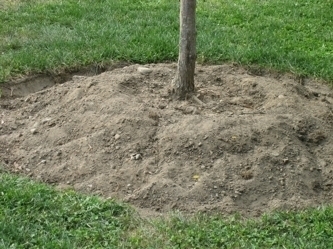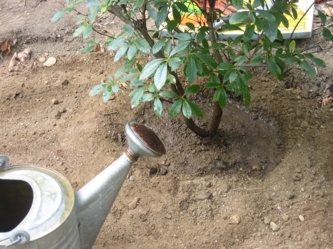Tree and Shrub Planting Guidelines
Location Selection
- Sun/shade-Full sun means that a site receives a minimum of 6-8 hours of direct sunlight per day. Most trees do best in full sun although several maple varieties, dogwoods, hornbeams, beech, spruce, and hemlock will tolerate some shade. As understory plants, many shrubs can thrive in light to medium shade although flowering may be decreased in heavy shade conditions.
- Drainage-To test the soil drainage, dig a hole 18 inches deep and fill it with water. Let it sit overnight and if the water has not drained by morning, the drainage is poor. Do not test drainage this way if it has just rained or if the ground has not thawed.
- Exposure-The south and west are generally warmer and drier although sites on the west may be exposed to westerly winds.
- Proximity to street/sidewalks-Plantings may be subjected to excess salt and compaction. Soils that are heavily compacted should be aerated.
- Slope-Extra care must be taken when planting on a slope. Visit the University of Georgia PDF for extensive information.
- Juglans toxicity-Trees or shrubs that are susceptible to Juglans toxicity should not be planted within 80 feet of a Black Walnut tree or where one has been in the past several years. Alder, apple and crabapple, azalea, basswood, cotoneaster, hydrangea, lilac, mountain laurel, peony, pine, privet, rhododendron, spruce, silver maple, white birch, and yew are particularly sensitive.
- Zoning-check with local zoning boards for regulations.
- Call Before You Dig- Check for underground wiring and utilities, call at least 2 days prior.
Site Evaluation and Preparation

Image by D. Pettinelli
Prior planning is the best course when planting trees or shrubs. Changes to soil pH and other amendments may require 6 months to take effect. A soil sample should be sent to the UConn Soil Nutrient Analysis Laboratory for testing using the form for additional soil tests. These tests will provide information on the soil textural analysis, organic matter percentage and soluble salts. Recommendations will be given for pH adjustments and amendments.
Plant Selection
Native plants should be selected if possible as they will have a better tolerance to climate conditions, drought tolerance, hardiness zones, insect pests, and diseases. Selected species should be native (Connecticut Native Tree and Shrub Availabilty List) and non-invasive. The Connecticut Invasive Plant Working Group has the current listing of invasive species. Consider mature plant height and width when planning the landscape. Placing trees and shrubs too closely at planting will cause issues later. If deer are an issue check out the UConn fact sheet Deer Resistant Trees, Shrubs, and Vines.
Trees and shrubs will be prepared for purchase in several ways but the most common are bare root, balled and burlapped, or containered.
- Bare root plants are dug from nursery fields in the spring or fall while in a dormant state although they are not planted until the spring. The soil is removed from the roots and if they are to be overwintered they are held in temperature and humidity-controlled storage. During transport and handling the roots should remain moist and protected from wind and sun. They made need to be soaked before planting. If the permanent site is not ready when the bare root plant arrives it should be temporarily planted in a shallow, protected area.
- Balled and burlapped plants are field-grown and are dug up with a firm root ball that is secured with burlap, twine, or wire. This process causes the loss of a large portion of the plants feeder roots which is why they must be planted 6-8 weeks before the stress of heat or cold. Do not carry b and b plants by the trunk but support from underneath the root ball. Keep plants in the shade until placed in the ground.
- Container grown plants will suffer the least amount of transfer shock but are the most susceptible to root girdling. If possible, lift the tree or shrub from the container and examine the roots. A plant with circling roots that are larger than the width of a finger is in danger of girdling the trunk and choking the tree and should not be purchased. Small circling roots should be pruned and the entire root ball should be scored vertically in 3-4 places with a sharp knife before planting.
When to Plant
Deciduous Trees and Shrubs
Bare root plants should be planted in the early spring while still dormant. Balled and burlapped plants can be placed in the spring or fall at least 6-8 weeks prior to periods of heat or cold that may stress them, usually April and September. Container grown plants have more leeway and be planted as late as May and October.
Evergreen Trees and Shrubs
Evergreens, especially the broadleaf variety, are best planted in the spring although the needled species may be planted safely in the early fall.
Planting
- Improper planting depth is one of the leading causes of plant failure. When the natural base flare is not apparent after planting then the depth is incorrect. Pull any mulch or burlap away from the base of the trunk to ascertain where the trunk begins to flare out which will determine the actual planting depth, do not assume that the level of soil from the nursery is any indication.

- The planting hole should be prepared before the tree or shrub is moved to the site. The hole should be as deep as the root ball and 2-3 times as wide, 3-5 times as wide in compacted soil. Measure from the trunk flare to the bottom of the root ball to determine proper depth keeping in mind that the plant may settle a bit after planting. It is more important that the hole be wide enough to allow the shallow root systems of most trees and shrubs to spread easily. To avoid root burn do not add any fertilizers or fresh manure.
- Once the hole has been prepared work quickly to get the plant in place before the roots are exposed to the drying effects of sun and wind. Cut away and remove any rope, twine, real or synthetic burlap, or plastic. Although burlap may decompose as much as may be removed should as it can wick moisture away from the roots.
- The trunk should be held as straight as possible as soil is replaced around the new planting. Lightly pack the soil around and under the bare roots or the root ball to eliminate air pockets. The application of water 1 or 2 times during the process will also help to reduce air pockets. Do not mound backfill above the level of the surrounding area.

Proper planting depth Image by D. Pettinelli
Staking/Wrapping
Staking prevents excess movement of the root system and is recommended for bare root trees taller than 6’ and balled and burlapped trees taller than 10’ that have unstable root balls or that are planted in high wind areas. Not all trees require staking and may develop smaller root systems if staked. The usual method for staking is three wires to be fastened to rubber loops about 1/3 up the height of the trunk and attached to stakes that are placed outside the perimeter of the root ball. This placement height is lower than was formerly recommended but it allows the tree to sway, which encourages a strong trunk. The stakes should be driven 12” deep into the firm soil. The loops around the tree trunk should be loose enough to prevent damage to the trunk. Stakes should be removed after one year.
Wrapping tree trunks is no longer standard procedure. If wrap is used on newly planted or thin-barked trees to prevent sunscald it should be removed in the spring and can be replaced in the fall until the tree has developed a thicker bark.
Fertilizer Requirements
Fertilizer applications should be based entirely on soil test results. Properly fertilized plants are better able to tolerate stress, drought, insects and pests. The root system of a tree can spread 1 ½ to 2 times the height of the tree therefore fertilizer should be spread over the entire root area, not just near the base of the tree. The basics of fertilization are covered in our fact sheet Tree, Shrub, Vine, and Groundcover Fertilization.
Water Requirements

Image by D. Pettinelli
Immediately after planting 2-3 gallons of water per inch of trunk diameter should be applied to the planting area. Newly planted trees and shrubs require 1 ½” water per week until new root growth becomes established. Water slowly and at ground level. Do not overwater as plants may drown from a lack of oxygen to their roots or develop root rot. Water until the ground freezes.
Mulching
Mulching can help reduce weeds, retain moisture, and moderate soil temperatures. Mulch should be placed at a depth of 2-3”, 3 times the diameter of the root ball, and should taper to a depth of 1-2” as it gets closer to the root ball. It should never touch the trunk. Mulch that is placed against the trunk encourages decay, allows entry points for diseases and pests, and gives cover to voles and rodents. Volcano mulching, where mulch is piled in a high cone against the trunk, should be avoided.
Pruning
Immediately after transplanting broken or damaged branches may be pruned. Do not prune the top of the tree although side branches may be pruned to improve form.
Despite good cultural practices, pests and diseases at times may appear. Chemical control should be used only after all other methods have failed.
For pesticide information or other questions please call toll free: 877-486-6271.
UConn Home and Garden Education Center, 2017
Issued in furtherance of Cooperative Extension work, Acts of May 8 and June 30, 1914, in cooperation with the U.S. Department of Agriculture, the Dean of the College, Cooperative Extension System, University of Connecticut, Storrs. The Connecticut Cooperative Extension System is an equal opportunity employer and program provider. To file a complaint of discrimination, write USDA, Director, Office of Civil Rights, Room 326-W, Whitten Building, Stop Code 9410, 1400 Independence Avenue, SW, Washington, DC 20250-9410 or call (202) 720-5964.